
FourmiFood
Sneaking Duck
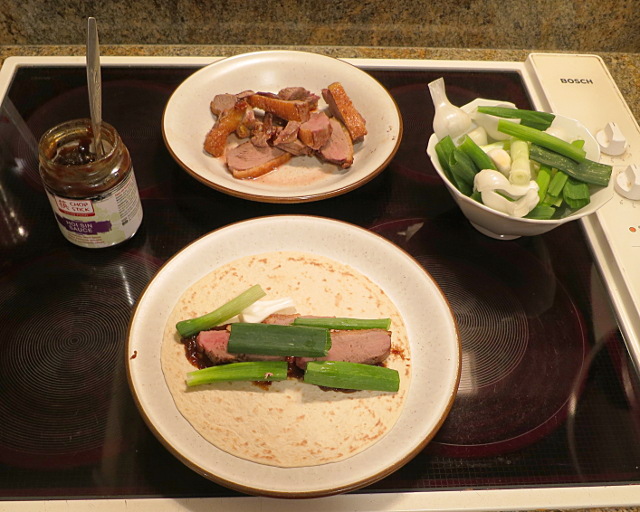

|
FourmiFoodSneaking Duck |

|
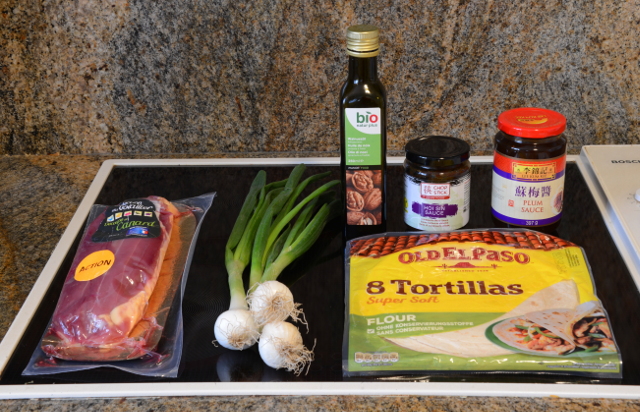
Peking duck (北京烤鸭) is a classic mainstay of Chinese cuisine. It is often a special treat on the menu of Chinese restaurants, requiring diners to order in advance for serving to multiple people. There's a reason for this: it's a major production to prepare and serve. The classic recipe takes three days: the first to remove the neck bones and knot the neck, paint the skin with honey and soy sauce, and hang to dry; the second to blow up the skin like a balloon to separate from the meat then blanch in boiling water; and the third to roast the whole duck in a wood-fired oven. As I recall, I've only had properly prepared Peking Duck once in my life, when a bunch of programmers at the place I worked in the 1970s arranged a Chinese banquet at a restaurant in Berkeley, California, but long before and after that I've made this recipe or variants, which I find excellent, if not authentic, and a tiny fraction of the work. You can look at this as a special treat, but making it couldn't be easier.
Collect the ingredients. Quantities are given per serving, so multiply by the number of people you're feeding.
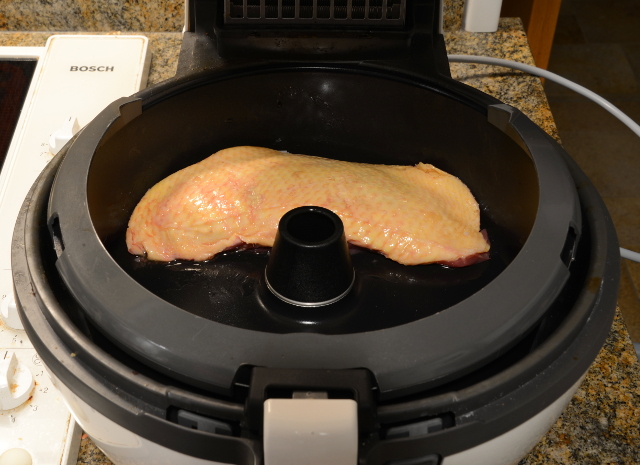 Remove the stirrer from the Actifry, add a small amount of cooking oil
to the pan, and drag the duck breast through it, covering both sides
and all the edges. Place the breast near the hot air port at the back
with the skin up.
Remove the stirrer from the Actifry, add a small amount of cooking oil
to the pan, and drag the duck breast through it, covering both sides
and all the edges. Place the breast near the hot air port at the back
with the skin up.
Set the Actifry timer for fifteen minutes and start cooking (there is no temperature setting). When the timer beeps, turn over the breast and cook for another fifteen minutes.
If you don't have an Actifry, this recipe will work perfectly well in a conventional (as opposed to a nuclear) oven set to “grill” (top heating element only) at 240° C. Turn the duck breast at the ten minute mark and cook for another ten minutes. You can also cook on a charcoal grill, but I've never tried this, so you'll have to experiment with the time. As with all poultry, you want to cook it “well done” (75° C core temperature, no pink inside) to avoid the risk of salmonella, but with this recipe that doesn't mean dry, tasteless food.
There is substantial variation in the size and shape of boneless duck
breasts you buy and the heat delivered by various cooking appliances.
The times I've given here are conservative and will usually result in
well-cooked meat. If your duck comes out undercooked (too pink when
you try to slice it, with lots of pink fluid running out), put it back
in for a bit longer and note the optimal time for the next go-round.
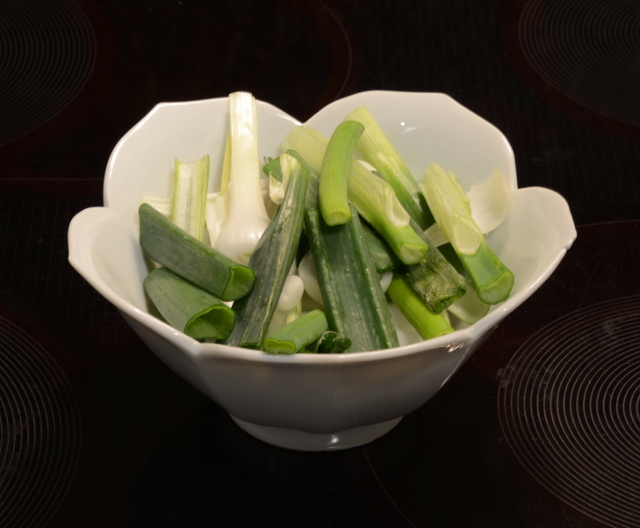 While the duck is cooking, there are a couple of tasks to occupy your
time. First of all, take two or three (depending upon their size)
green onions (or scallions) and slice them, greens and bulb, into
pieces around 7 cm long. If the bulb is large,
as we often get in Europe, cut it into two pieces and separate.
Place in a bowl for serving at the table.
While the duck is cooking, there are a couple of tasks to occupy your
time. First of all, take two or three (depending upon their size)
green onions (or scallions) and slice them, greens and bulb, into
pieces around 7 cm long. If the bulb is large,
as we often get in Europe, cut it into two pieces and separate.
Place in a bowl for serving at the table.
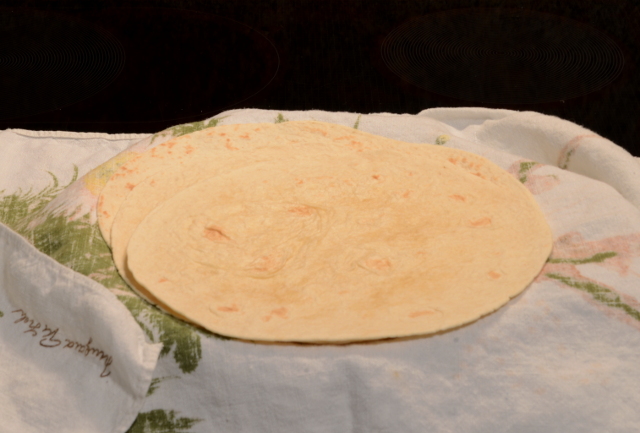
Next, we turn to preparing the “pancakes” in which the duck and onions will be rolled. Doing this the proper way is an enormously fussy and messy procedure so, as usual, we'll do it the wrong way, which is tasty if inauthentic. Get some store-bought flour tortillas for Mexican food, around four per person. The proper pancakes for Peking duck are thinner, but they have essentially the same ingredients and, let me tell you from experience, you don't want to try to make them at home.
Traditionally, these pancakes, after preparation in a frying pan,
are steamed before serving. More complexity and mess, which we
jettison for FourmiFood. Take a dinner plate and place a dish
towel on top of it with the tortillas, separated first so they
don't stick together.
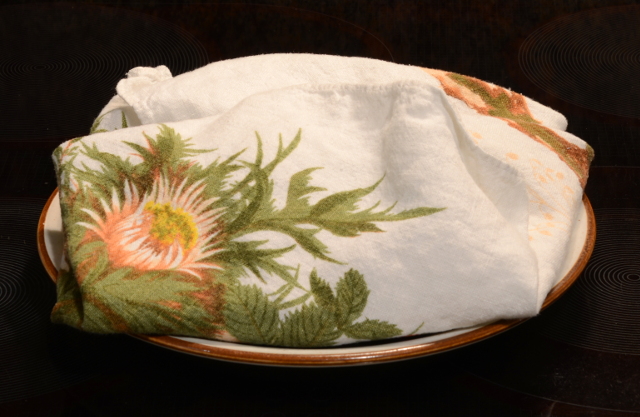 Fold the towel over the tortillas, sprinkle with a little water (I
usually drizzle a bit from a measuring cup) and place in the
microwave oven. We'll nuke 'em as serving time approaches.
Fold the towel over the tortillas, sprinkle with a little water (I
usually drizzle a bit from a measuring cup) and place in the
microwave oven. We'll nuke 'em as serving time approaches.
At this point, you'll just be waiting to turn over the duck breast and
start cooking the other side. After you turn it over and the counter
reaches around two minutes from the Blessed Beep of Eating, start the
microwave on the tortillas on their plate with the moistened towel.
With Fourmilab's strategic-scale microwave, one minute does the job,
but if you have a less powerful tactical unit, you may have to nuke
it for a bit longer. The tortillas should come out warm and steamy,
but not too hot to pick up with your bare hands.
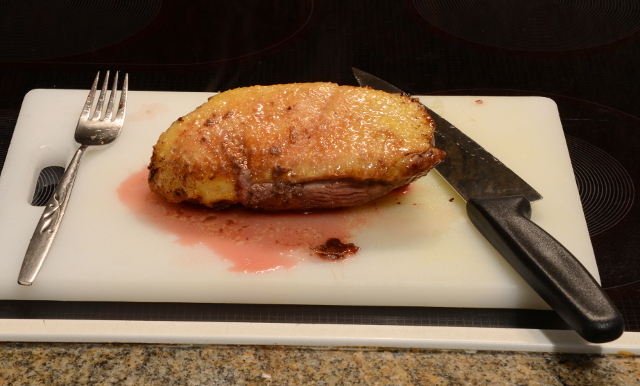
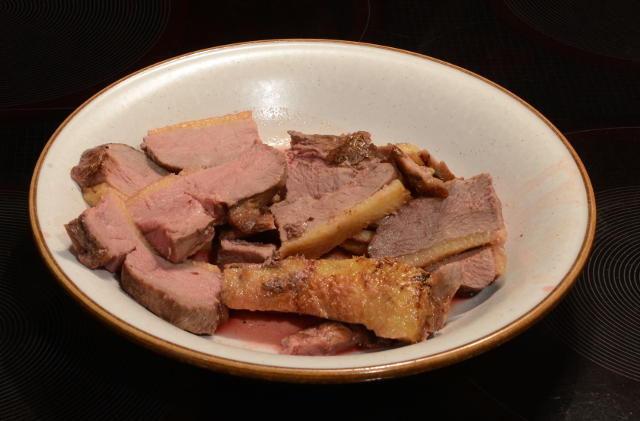 By this time, the yummy smells of the cooking duck should have
attracted the entire household to the kitchen. It's time to deliver on
that olfactory promise. Remove the duck breast from the Actifry or
oven to a cutting board (the one in this picture was a tad undercooked:
I ended up cooking it for a few minutes more before serving).
By this time, the yummy smells of the cooking duck should have
attracted the entire household to the kitchen. It's time to deliver on
that olfactory promise. Remove the duck breast from the Actifry or
oven to a cutting board (the one in this picture was a tad undercooked:
I ended up cooking it for a few minutes more before serving).
Slice the cooked duck breast into pieces around 5 cm long and bite-size thin, trying to keep a bit of the tasty skin on each slice. Serve them in a dish or on a plate whence diners can pick pieces of meat to fill their pancakes.

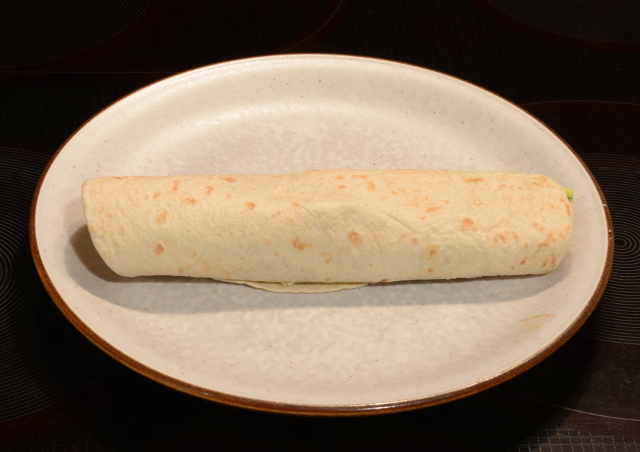 At the table, serve the sliced meat, tortillas in their towel
(only unwrap to take one out—that keeps the rest warm and
moist), plum and hoisin sauces, and sliced onions. Each diner
takes a tortilla, spreads the sauce of choice (hoisin if you
like salty, plum if sweet) down the middle, places a few pieces
of duck and some onion slices on the top, then rolls it up and
chows down, The final product, ready to eat, doesn't look
inspiring but it's delicious.
At the table, serve the sliced meat, tortillas in their towel
(only unwrap to take one out—that keeps the rest warm and
moist), plum and hoisin sauces, and sliced onions. Each diner
takes a tortilla, spreads the sauce of choice (hoisin if you
like salty, plum if sweet) down the middle, places a few pieces
of duck and some onion slices on the top, then rolls it up and
chows down, The final product, ready to eat, doesn't look
inspiring but it's delicious.
Unlike authentic Peking duck, where the banquet is followed by a tedious process of abstergification in the scullery after the diners have departed, Sneaking Duck requires only throwing the Actifry pan and filter, dishes, and utensils in the dish grinder and pressing the magic button. This is so easy to make you can really have it as often as you wish, and it's not even that fattening. But at Fourmilab, we prefer to reserve it as a special treat.
Bon appetit!